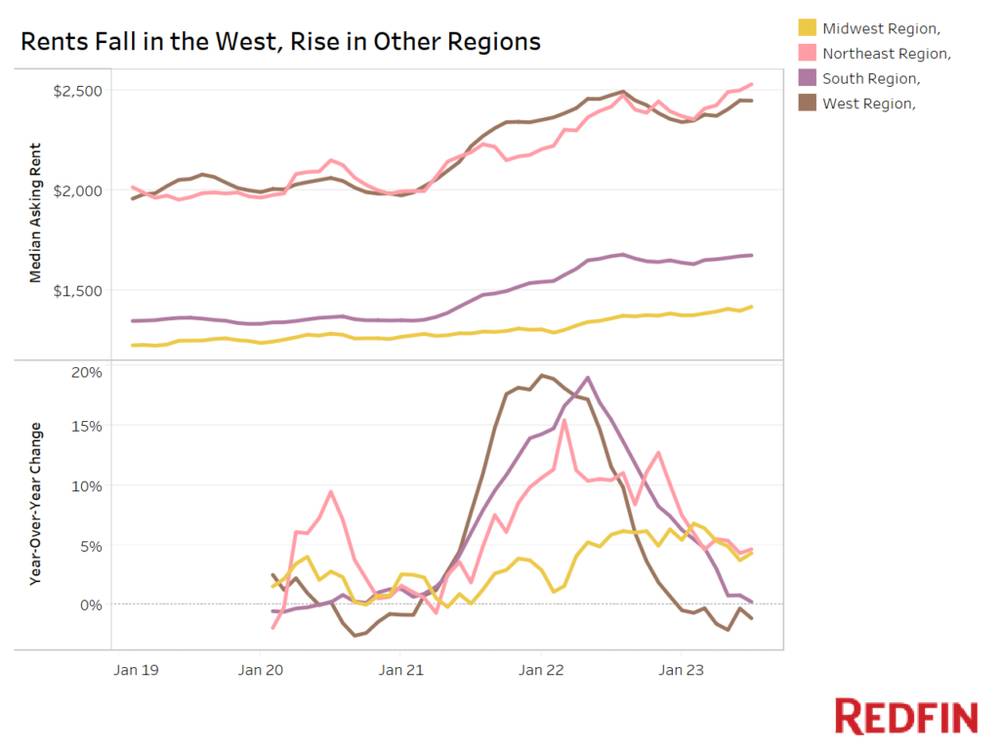During the pandemic, the number of people leaving large metro areas like New York City, Los Angeles, San Francisco, and Chicago increased dramatically. Enabled by remote work and seeking more space for less money, they moved to Sun Belt metros like Phoenix, Austin, and Tampa.
The influx of new residents caused skyrocketing rent and home prices, but both are now declining. Some reports predict migration back to the major urban hubs, where job opportunities are plentiful and many companies are requiring hybrid work arrangements.
But existing residents who were priced out of Sun Belt cities will need cheaper havens. In July, we reported that migration trends were already showing a preference for the Northeast as people left the South. And other evidence indicates that the rental market in the newly revitalized Rust Belt is heating up as people look for the cheapest (but still desirable) places to live.
For investors seeking long-distance opportunities, these markets are well worth considering.
Why the Rust Belt and Northeast May Appeal to Real Estate Investors
So why are these regions so appealing right now? There are a few reasons.
1. Rents are rising fastest in the Northeast and Midwest
Asking rents in the South exhibited the smallest year-over-year increase as of July, according to Redfin, while median asking rents in the West fell 1.1% year over year. But in the Northeast and the Midwest, asking rents climbed to record highs. The new median asking rent in the Northeast was $2,533, 4.6% higher than a year ago, while the median asking rent in the Midwest increased 4.3% to $1,416.

2. These three Rust Belt cities have the best rent-to-price ratios
Redfin also reports that homeownership is more affordable than renting in only four cities. The cities where the most properties are cheaper to buy than rent are Detroit, Philadelphia, Cleveland, and Houston. That gives investors a greater selection of cash-flow properties to choose from. For 80% of properties in Detroit, the median mortgage payment is less than the median rent, for example.
Meanwhile, in the Bay Area, buying costs more than double when compared to renting. And in pandemic boomtowns like Phoenix, only a tiny share of properties are cheaper to buy than rent.
3. Some housing prices in the Rust Belt and Northeast are some of the cheapest in the nation
Then there’s the low barrier to entry. Many Rust Belt and Northeast cities are among the cheapest in the country, according to a Forbes ranking of the 100 most populous metro areas. Detroit ranked as the cheapest city to buy a home, followed by Cleveland and Toledo, Ohio. Median home prices in many of the metro areas in the Rust Belt and Northeast are well below the national median.
4. Tech companies are revitalizing the Rust Belt
We love cheap properties, but if an area has stagnant prices and a sluggish economy with no hope of future growth, that’s a point of concern for investors.
But the Rust Belt shows promise. Cities like Pittsburgh, Cleveland, Detroit, and Youngstown, Ohio, are undergoing a high-tech renaissance. Over 18,000 startups have popped up in the region over the last decade, and investment in Middle America is growing, thanks to a venture firm launched in Columbus, Ohio. Tech giants like Alphabet, Apple, Amazon, and Meta Platforms (the company formerly known as Facebook) are expanding their hiring efforts in Pittsburgh due to affordability, room for growth, and a hotbed of talent from universities in the area.
And while blue-collar jobs at steel mills and coal mines aren’t coming back, innovative, practical applications of technology are creating new jobs. Midwestern hubs may even evolve to become the next Silicon Valley, following in Austin’s footsteps, though the technology-led revitalization hasn’t reached all areas of the Rust Belt just yet.
5. People are being priced out of nearby markets
While rents in New York City dipped during the pandemic, as of June, rents are now 30% higher in Manhattan and 20% higher in Brooklyn compared to 2020 prices. And Chicago rents have grown at triple the national average rate over the past year. These cities, which already had rents above the national average, are becoming increasingly unaffordable for many.
For those who are able to move, nearby cities in New York and the Midwest may be the most logical relocation choice. Far-away moves have also become more common. Recent migration reports show renters from cities like St. Louis, Chicago, and Denver are all interested in relocating to cheaper Midwestern cities. Migration trends also indicate New York City residents are interested in relocating to the Harrisburg-Lancaster-Lebanon-York, Pennsylvania metro.
Notable Northeast and Rust Belt Markets That May Become Hotbeds For Investors
To provide a snapshot of investment opportunities in the Rust Belt and Northeast, we collected data for 15 notable cities in the region from various sources. We pulled median home price, home price growth, and median days on the market data from Redfin and average rent price and rent growth from Rent.com. All figures are accurate as of publication.
We also retrieved metro rental vacancy rate data for the second quarter of 2023 from the Census Bureau, where available.
| City | Median Home Price | YoY Home Price Change | Average Rent, 2BR | YoY Rent Change, 2BR | Rent-to-Price (RTP) Ratio | Median Days on the Market | Metro Rental Vacancy Rate |
| Detroit, Michigan | $85,000 | -11.5% | $1,617 | 0% | 1.90% | 34 | 8.7% |
| Cleveland, Ohio | $116,500 | -9.16% | $2,074 | +3% | 1.78% | 22 | 1.6% |
| Rochester, New York | $182,475 | +16% | $1,855 | +10% | 1.03% | 8 | 2.3% |
| York, Pennsylvania | $160,000 | +6.7% | $1,443 | +5% | 0.90% | 9 | N/A |
| Trenton, New Jersey | $225,000 | +60.7% | $1,875 | +8% | 0.83% | 47 | N/A |
| Buffalo, New York | $208,000 | +4% | $1,660 | +6% | 0.80% | 11 | 10.3% |
| Syracuse, New York | $163,250 | -1.1% | $1,249 | -10% | 0.77% | 15 | 8.3% |
| Philadelphia, Pennsylvania | $275,000 | +1.9% | $2,025 | -9% | 0.74% | 42 | 5.6% |
| Lancaster, Pennsylvania | $240,000 | -13.7% | $1,780 | +8% | 0.74% | 6 | N/A |
| Troy, New York | $215,000 | +1.7% | $1,552 | +7% | 0.72% | 7 | 0.9% |
| Fort Wayne, Indiana | $215,000 | +10.3% | $1,539 | +59% | 0.72% | 5 | N/A |
| Albany, New York | $265,000 | +8.2% | $1,687 | +11% | 0.64% | 11 | 0.9% |
| Youngstown, Ohio | $141,000 | +23.7% | $900 | +18% | 0.64% | 29 | N/A |
| Pittsburgh, Pennsylvania | $260,000 | +4% | $1,619 | -19% | 0.62% | 51 | 3.2% |
| Cincinnati, Ohio | $280,000 | +10.9% | $1,622 | 0% | 0.58% | 6 | 6% |
Many of the cities on this list were ranked in the top 100 Best Places to Live by U.S. News and World Report, including four cities in western or upstate New York: Albany (No. 17), Syracuse (No. 22), Rochester (No. 26), and Buffalo (No. 27). The ranking methodology considers factors like the job market, desirability, quality of life, and value. Other ranking cities include Fort Wayne, Indiana (No. 33), Pittsburgh (No. 47), and Cincinnati (No. 50).
Notably, home prices in these cities are all well below the national median home price of $421,774 (as of July), according to Redfin. And many of them boast strong rent prices as well. Cleveland and Detroit have especially low home prices and comparatively high average rents. And rent prices are growing rapidly in cities like Fort Wayne and Youngstown.
The national rental vacancy rate was at 6.3% in the second quarter of 2023, up from 5.6% in the same period in 2022. Metros that include cities like Albany, Troy, Cleveland, Rochester, and Pittsburgh all have very low rental vacancy rates relative to the nationwide rate, indicating strong rental demand. Cleveland, in particular, has maintained low rental vacancy rates over the last several years.
Finally, the rent-to-price (RTP) ratio is favorable for many of these markets. Detroit, Cleveland, and Rochester all have ratios above 1%, and half a dozen others are within 30 basis points of that target. It’s important to note these home and rent prices are based on city-wide figures, and, with a little research, you will likely be able to find better deals in specific neighborhoods. For instance, Philadelphia has a RTP ratio of 0.74%, but there are a few ZIP codes in the city with ratios above 1%.
The Bottom Line
The Rust Belt and Northeast are regions to watch for investors, as rents in the Sun Belt have the most room to decline after skyrocketing due to migration during the pandemic. Though areas of the South are still popular with people relocating from large cities, inflated prices there mean that investors will have fewer choices when it comes to cheap properties that will generate strong cash flow. In Cleveland and Detroit, for example, properties are available for what may seem like pocket change to investors accustomed to more expensive areas.
Though we haven’t ranked the best cities in the Northeast and the Rust Belt, we’ve highlighted several examples of potential markets as a starting point for your research. As always, it’s important to get specific and evaluate neighborhoods and individual properties. Look for bargains, and crunch the numbers to ensure you’ll get a strong return on your investment.
But don’t rule out the Rust Belt and Northeast as you analyze a potential market—the low barriers to entry and strong growth potential make these areas worth evaluating.
Join the community
Ready to succeed in real estate investing? Create a free BiggerPockets account to learn about investment strategies; ask questions and get answers from our community of +2 million members; connect with investor-friendly agents; and so much more.
Note By BiggerPockets: These are opinions written by the author and do not necessarily represent the opinions of BiggerPockets.

